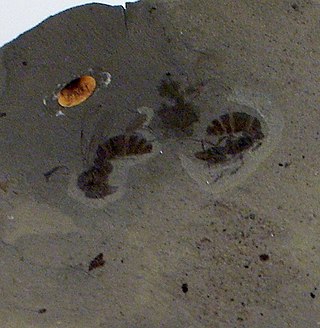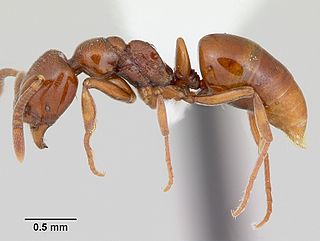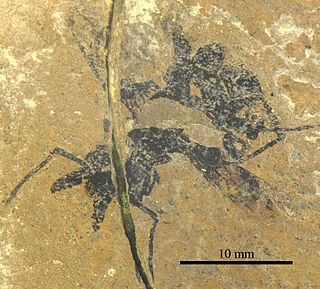
Ponerinae, the ponerine ants, is a subfamily of ants in the Poneromorph subfamilies group, with about 1,600 species in 47 extant genera, including Dinoponera gigantea - one of the world's largest species of ant. Mated workers have replaced the queen as the functional egg-layers in several species of ponerine ants. In such queenless species, the reproductive status of workers can only be determined through ovarian dissections.

Harpegnathos is a small ponerine genus of ants found in South and Southeast Asia. They are notable for their jumping ability, complex colony structure, and large to very large workers easily identifiable by their long mandibles and large eyes.

Pachycondyla is a ponerine genus of ants found in the Neotropics.

Feroponera is a monotypic Afrotropical genus of ants in the subfamily Ponerinae containing the single species Feroponera ferox. The genus is known only from a few specimens collected from an unoccupied termitary in Cameroon.

Simopelta is a Neotropical genus of ants in the subfamily Ponerinae.

Thaumatomyrmex is a Neotropical genus of ants in the subfamily Ponerinae, found from Mexico to Brazil. They are notable for their pitchfork-shaped mandibles, which they use to capture millipedes of the order Polyxenida. The genus is a specialist predator of polyxenids, and one of only two ant genera known to prey upon polyxenids.

Ypresiomyrma is an extinct genus of ants in the subfamily Myrmeciinae that was described in 2006. There are four species described; one species is from the Isle of Fur in Denmark, two are from the McAbee Fossil Beds in British Columbia, Canada, and the fourth from the Bol’shaya Svetlovodnaya fossil site in Russia. The queens of this genus are large, the mandibles are elongated and the eyes are well developed; a stinger is also present. The behaviour of these ants would have been similar to that of extant Myrmeciinae ants, such as solitary foraging for arthropod prey and never leaving pheromone trails. The alates were poor flyers due to their size, and birds and animals most likely preyed on these ants. Ypresiomyrma is not assigned to any tribe, and is instead generally regarded as incertae sedis within Myrmeciinae. However, some authors believe Ypresiomyrma should be assigned as incertae sedis within Formicidae.

Dinoponera is a strictly South American genus of ant in the subfamily Ponerinae, commonly called tocandiras or giant Amazonian ants. These ants are generally less well known than Paraponera clavata, the bullet ant, yet Dinoponera females may surpass 3–4 cm (1.2–1.6 in) in total body length, making them among the largest ants in the world.

Mystrium is a rare genus of ants in the subfamily Amblyoponinae. First described by Roger (1862) with the description of the queen of M. mysticum, the genus contains 14 species, all of which occur in the rainforests of the Old World with over half of the species endemic to the Malagasy region.

Brownimecia is an extinct genus of ants, the only genus in the tribe Brownimeciini and subfamily Brownimeciinae of the Formicidae. Fossils of the single identified species, Brownimecia clavata, are known from the Middle Cretaceous of North America. The genus is one of several ants described from Middle Cretaceous ambers of New Jersey. Brownimecia was initially placed in the subfamily Ponerinae, until it was transferred to its own subfamily in 2003; it can be distinguished from other ants due to its unusual sickle-like mandibles and other morphological features that makes this ant unique among the Formicidae. The ant is also small, measuring 3.43 millimetres (0.135 in), and a stinger is present in almost all of the specimens collected. The morphology of the mandibles suggest a high level of feeding specialization.

Tyrannomyrmex is a rare tropical genus of ants in the subfamily Myrmicinae. Three similar species, only known from workers, are recognized and share small eyes and edentate mandibles.

Asphinctopone is a small genus of rarely encountered Afrotropical ants in the subfamily Ponerinae.

Boloponera is a genus of small ants in the subfamily Ponerinae. The genus contains the single species Boloponera vicans, known from a single worker specimen collected in leaf litter in the Central African Republic. It is sometimes referred to as Bry's ant after its discoverer, Brian Fisher.

Promyopias is an Afrotropical genus of ant in the subfamily Ponerinae containing the single species Promyopias silvestrii. The rare genus has previously been regarded as a separate genus, as a subgenus and as a provisional synonymy, but was reinstated at genus-rank in 2008.

Ravavy is a Malagasy genus of ant in the subfamily Dolichoderinae containing the single species Ravavy miafina.

Bothroponera is a genus of ants in the subfamily Ponerinae. It is distributed in Africa and Asia.

Archimyrmex is an extinct genus of ant in the formicid subfamily Myrmeciinae, described by palaeoentomologist Theodore Cockerell in 1923. The genus contains four described species, Archimyrmex rostratus, Archimyrmex piatnitzkyi, Archimyrmex smekali and Archimyrmex wedmannae. Archimyrmex is known from a group of Middle Eocene fossils which were found in North America, South America, and Europe. The genus was initially placed in the subfamily Ponerinae, but it was later placed in Myrmeciinae; it is now believed to be the ancestor of the extant primitive genus Myrmecia from Australia. Despite this, Archimyrmex is not a member to any tribe and is regarded as incertae sedis within Myrmeciinae. However, some authors believe Archimyrmex should be assigned as incertae sedis within Formicidae. These ants can be characterised by their large mandibles and body length, ranging from 13.2 to 30 mm. They also have long, thin legs and an elongated mesosoma (thorax) and petiole.

Buniapone is a monotypic genus of ants in the subfamily Ponerinae. Buniapone amblyops, the single described species, is found in Southern and Southeast Asia.

Cephalopone is an extinct genus of ants in the formicid subfamily Ponerinae described from fossils found in Europe. There are two described species placed into the genus, Cephalopone grandis and Cephalopone potens. Cephalopone is one several Lutetian Ponerinae genera.

Messelepone is an extinct genus of ants in the formicid subfamily Ponerinae described from fossils found in Europe. M. leptogenoides is the only species assigned to the genus, which is one of several Lutetian Ponerinae genera.



















